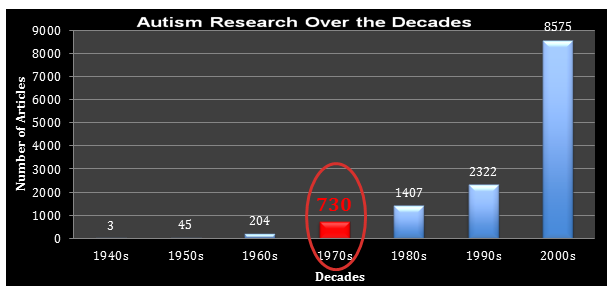The 1970s
Highlights
• First demonstration of genetic basis of autism
• Attachment theory discredited
• Second form of Rimland Checklist published
• Language problems recognized to be due not to severe language impairment but to a language delay, which is a critical characteristic of autism
• Children with autism shown to have a cognitive defect that affects interpersonal verbal and nonverbal communication
• Research inadequate and inconsistent

| 1940s | 1950s | 1960s | 1970s | 1980s | 1990s | 2000s |
Research in the 1970s
In the 1970s, the psychiatrists Susan Folstein of Tufts University and Sir Michael Rutter (of University College London) published a study of twins with autism, proving that autism had a genetic basis.[1] Rutter also modified Bowlby’s attachment theory, concluding that lack of maternal attachment was a “vulnerability factor” rather than a “causative agent” for autism. The common understanding of autism’s underlying cause shifted more toward genetic predisposition or injury during development.[1][2][3] Researchers also discovered that the language problems of a child with autism were due not to severe language impairment but rather to a language delay.[4] This language delay was pivotal in distinguishing autism from other neurodevelopmental disorders, specifically dysphasia.[4] In addition, new studies indicated that children with autism had a cognitive defect that affected processing of interpersonal verbal and nonverbal communication.[5] Researchers decided to determine whether failure to respond to certain stimuli (one of two) would be an important factor in the development of autism,[6] as individuals who were mentally disabled would respond to two. The methodology used in the 1970s was inadequate and inconsistent, leading to sweeping generalizations about autism.[7]
Ross Senter, Karthik Kumar, and Sharmila Banerjee-Basu, Ph.D.
| References: |
|

